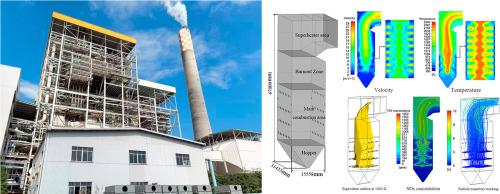Combustion characteristics and pollutant emissions of coal and eucalyptus co-firing in a 1000 MW ultra-supercritical wall-fired boiler
IF 6.3
3区 工程技术
Q1 ENGINEERING, CHEMICAL
Journal of the Taiwan Institute of Chemical Engineers
Pub Date : 2025-08-05
DOI:10.1016/j.jtice.2025.106320
引用次数: 0
Abstract
Background
The rapid development of renewable energy has led to a decline in the market share of thermal power generation, conventional coal-fired plants now face intensified demands for flexible operation for boiler units. However, the effect of boiler load and over-fire air (OFA) ratios on co-combustion characteristics and pollutant emission characteristics of coal and biomass to be clarified.
Methods
This paper studied a 1000 MW ultra-supercritical wall-fired boiler blended with 10 % eucalyptus wood (calculated based on calorific value) under different loads (BMCR, THA, 75 % THA, 50 % THA, 40 % THA) by computational fluid dynamics (CFD) simulation. And the effect of different OFA ratios at 40 %THA was further analyzed.
Significant Findings
The results demonstrate that load reduction induces progressive flow field degradation, with average temperature dropping 121 K from BMCR to 40 %THA. NOx emission demonstrates non-monotonic variation, recording concentrations of 232, 226, 222, 245, and 251 ppm across loads. Increasing OFA ratio from 15 % to 25 % enhances combustion efficiency while reducing NOx concentration by 7.29 %. Further elevation to 30 % OFA ratio leads to a slight increase in gas temperature and the heat flux, but the NOx concentration increases from 234 to 271 ppm. 25 % OFA ratio is beneficial to heat transfer and low NOx emission.

1000mw超超临界壁式锅炉煤与桉树共烧燃烧特性及污染物排放
背景:可再生能源的快速发展导致火电市场份额的下降,传统燃煤电厂对锅炉机组灵活运行的需求加剧。但是,锅炉负荷和过火空气(OFA)比对煤与生物质共燃特性和污染物排放特性的影响还有待明确。方法采用计算流体力学(CFD)方法,对1000mw超超临界壁挂式锅炉在不同负荷(BMCR、THA、75% THA、50% THA、40% THA)下,掺加10%桉木(按热值计算)进行了模拟研究。并进一步分析了不同OFA比例对40% THA的影响。结果表明,负荷减少导致流场逐渐退化,平均温度从BMCR下降到40% THA,下降了121 K。NOx排放表现出非单调变化,记录的浓度为232、226、222、245和251 ppm。将OFA比例从15%提高到25%,燃烧效率提高,NOx浓度降低7.29%。OFA比进一步提高到30%,气体温度和热流密度略有升高,但NOx浓度从234增加到271 ppm。25%的OFA比有利于传热和低NOx排放。
本文章由计算机程序翻译,如有差异,请以英文原文为准。
求助全文
约1分钟内获得全文
求助全文
来源期刊
CiteScore
9.10
自引率
14.00%
发文量
362
审稿时长
35 days
期刊介绍:
Journal of the Taiwan Institute of Chemical Engineers (formerly known as Journal of the Chinese Institute of Chemical Engineers) publishes original works, from fundamental principles to practical applications, in the broad field of chemical engineering with special focus on three aspects: Chemical and Biomolecular Science and Technology, Energy and Environmental Science and Technology, and Materials Science and Technology. Authors should choose for their manuscript an appropriate aspect section and a few related classifications when submitting to the journal online.

 求助内容:
求助内容: 应助结果提醒方式:
应助结果提醒方式:


